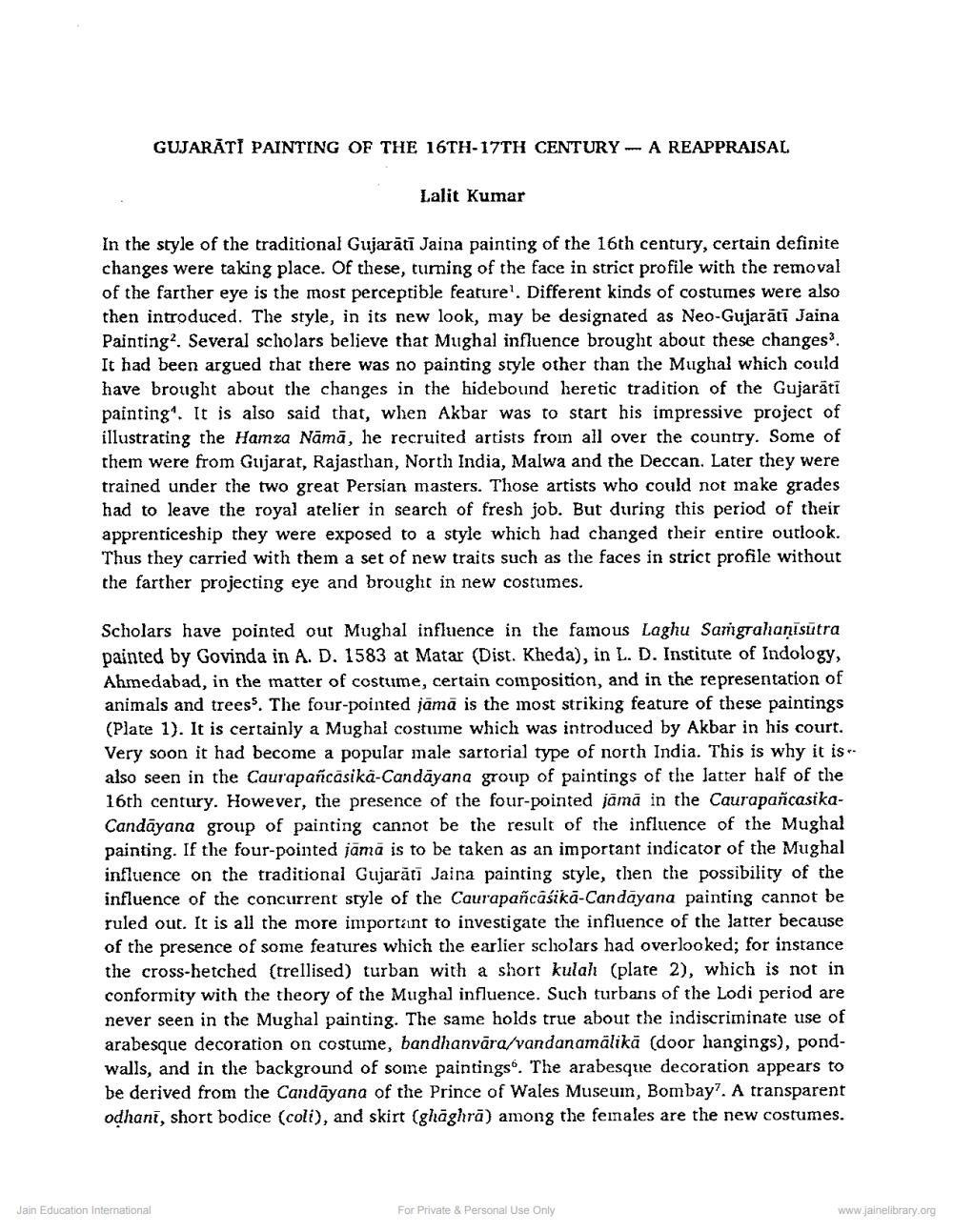Book Title: Gujarati Painting of 16th 17th Century Author(s): Lalit Kumar Publisher: Z_Nirgrantha_1_022701.pdf and Nirgrantha_2_022702.pdf and Nirgrantha_3_022703.pdf View full book textPage 1
________________ GUJARĀTI PAINTING OF THE 16TH-17TH CENTURY A REAPPRAISAL Lalit Kumar In the style of the traditional Gujarati Jaina painting of the 16th century, certain definite changes were taking place. Of these, turning of the face in strict profile with the removal of the farther eye is the most perceptible feature'. Different kinds of costumes were also then introduced. The style, in its new look, may be designated as Neo-Gujarātī Jaina Painting. Several scholars believe that Mughal influence brought about these changes. It had been argued that there was no painting style other than the Mughal which could have brought about the changes in the hidebound heretic tradition of the Gujarāti painting". It is also said that, when Akbar was to start his impressive project of illustrating the Hamza Nāmā, he recruited artists froin all over the country. Some of them were from Gujarat, Rajasthan, North India, Malwa and the Deccan. Later they were trained under the two great Persian masters. Those artists who could not make grades had to leave the royal atelier in search of fresh job. But during this period of their apprenticeship they were exposed to a style which had changed their entire outlook. Thus they carried with them a set of new traits such as the faces in strict profile without the farther projecting eye and brought in new costumes. Scholars have pointed out Mughal influence in the famous Laghu Sangrahanīsutra painted by Govinda in A. D. 1583 at Matar (Dist. Kheda), in L. D. Institute of Indology, Ahmedabad, in the matter of costume, certain composition, and in the representation of animals and treess. The four-pointed jämā is the most striking feature of these paintings (Plate 1). It is certainly a Mughal costume which was introduced by Akbar in his court. Very soon it had become a popular male sartorial type of north India. This is why it is - also seen in the Caurapañcâsika-Candāyana group of paintings of the latter half of the 16th century. However, the presence of the four-pointed jāma in the CaurapañcasikaCandāyana group of painting cannot be the result of the influence of the Mughal painting. If the four-pointed jamā is to be taken as an important indicator of the Mughal influence on the traditional Gujarātī Jaina painting style, then the possibility of the influence of the concurrent style of the Caurapañcāśikā-Candāyana painting cannot be ruled out. It is all the more important to investigate the influence of the latter because of the presence of some features which the earlier scholars had overlooked; for instance the cross-hetched (trellised) turban with a short kulah (plate 2), which is not in conformity with the theory of the Mughal influence. Such turbans of the Lodi period are never seen in the Mughal painting. The same holds true about the indiscriminate use of arabesque decoration on costume, bandhanvāra/vandanamālikā (door hangings), pondwalls, and in the background of some paintings. The arabesque decoration appears to be derived from the Candāyana of the Prince of Wales Museum, Bombay?. A transparent odhani, short bodice (coli), and skirt (ghāghrā) among the females are the new costumes. Jain Education International For Private & Personal Use Only www.jainelibrary.orgPage Navigation
1 2 3 4 5 6 7 8 9 10 11 12 ... 18
